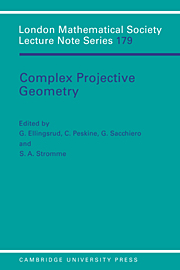Book contents
- Frontmatter
- Contents
- INTRODUCTION
- PROJECTIVE VARIETIES
- VECTOR BUNDLES AND SPECIAL PROJECTIVE EMBEDDINGS
- LIST OF PARTICIPANTS
- Speciality one rational surfaces in P4
- Bounding sections of bundles on curves
- The smooth surfaces of degree 9 in P4
- Compactifying the space of elliptic quartic curves
- Threefolds of degree 11 in P5
- Complete extensions and their map to moduli space
- On the Betti numbers of the moduli space of stable bundles of rank two on a curve
- Gaussian maps for certain families of canonical curves
- Geometry of the Horrocks bundle on P3
- Stability and restrictions of Picard bundles, with an application to the normal bundles of elliptic curves
- Sections planes et majoration du genre des courbes gauches
- A tribute to Corrado Segre
- Un aperçu des travaux mathématiques de G.H. Halphen (1844–1889)
- The source double-point cycle of a finite map of codimension one
- Fibré déterminant et courbes de saut sur les surfaces algébriques
- Courbes minimales dans les classes de biliaison
- Fano 3-folds
- Polarized K3 surfaces of genus 18 and 20
- Protective compactifications of complex afflne varieties
- On generalized Laudal's lemma
- Sur la stabilité des sous-variétés lagrangiennes des variétés symplectiques holomorphes
- Introduction to Gaussian maps on an algebraic curve
- Some examples of obstructed curves in P3
Threefolds of degree 11 in P5
Published online by Cambridge University Press: 06 July 2010
- Frontmatter
- Contents
- INTRODUCTION
- PROJECTIVE VARIETIES
- VECTOR BUNDLES AND SPECIAL PROJECTIVE EMBEDDINGS
- LIST OF PARTICIPANTS
- Speciality one rational surfaces in P4
- Bounding sections of bundles on curves
- The smooth surfaces of degree 9 in P4
- Compactifying the space of elliptic quartic curves
- Threefolds of degree 11 in P5
- Complete extensions and their map to moduli space
- On the Betti numbers of the moduli space of stable bundles of rank two on a curve
- Gaussian maps for certain families of canonical curves
- Geometry of the Horrocks bundle on P3
- Stability and restrictions of Picard bundles, with an application to the normal bundles of elliptic curves
- Sections planes et majoration du genre des courbes gauches
- A tribute to Corrado Segre
- Un aperçu des travaux mathématiques de G.H. Halphen (1844–1889)
- The source double-point cycle of a finite map of codimension one
- Fibré déterminant et courbes de saut sur les surfaces algébriques
- Courbes minimales dans les classes de biliaison
- Fano 3-folds
- Polarized K3 surfaces of genus 18 and 20
- Protective compactifications of complex afflne varieties
- On generalized Laudal's lemma
- Sur la stabilité des sous-variétés lagrangiennes des variétés symplectiques holomorphes
- Introduction to Gaussian maps on an algebraic curve
- Some examples of obstructed curves in P3
Summary
Introduction. This article is devoted to the classification of smooth projective threefolds in P5.
In [BSS] we classified degree 9 and 10 threefolds in P5; the lower degree varieties had already been classified (see [11], [12], [13], [O1], [O2]). In that article, we used known constraints and new results from adjunction theory ([BBS], [S1], [S5], [SV]) to restrict the possible invariants. We then used liaison to construct examples with the possible invariants. Uniqueness of the examples satisfying the invariants was also shown.
In this paper we extend the methods of [BSS] to deal with the degree 11 case. The list we obtain of the possible invariants is again short, and we have examples for every possible set of invariants. We refer the reader to the start of § 4 where there is a table giving the degree 11 classification. For the reader's convenience we have given a one page appendix to this paper with a table giving the known classification of degree ≤ 10 threefolds in P5.
Degree 11 is especially interesting because our calculations show that the number of possible sets of invariants begins to increase quite fast from degree 12 on. This is discussed in (4.6).
We would like to thank the DFG-Schwerpunktprogram “Komplexe Mannigfaltigkeiten” for making it possible for us to work together at the University of Bayreuth in the summer of 1988. The third author would like to thank the National Science Foundation (DMS 87-22330 and DMS 89-21702). The first and the third author would like to thank the University of Notre Dame for its support. We would like to thank Ms. Cinzia Matrl for the excellent typing.
- Type
- Chapter
- Information
- Complex Projective GeometrySelected Papers, pp. 59 - 80Publisher: Cambridge University PressPrint publication year: 1992
- 5
- Cited by

